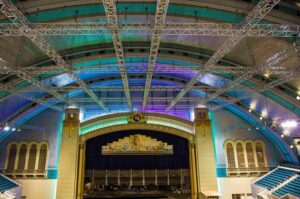All theatre and performance spaces are different and require specific equipment to help deliver engaging productions. Learn about different types of rigging and their unique benefits.

Manual Rigging Equipment
Manual rigging includes tools and equipment that raise, lower and control different onstage elements that enhance visual effects.
Manual rigging equipment includes:
Block systems: Head, loft, pivot, floor and mule blocks are designed to manage lift lines in various configurations. Blocks can be used in single or multi-line designs as well as upright and underhung versions.
Counterweight arbors: Metal weights balance the load of battens, scenery and lights on an arbor system, allowing your crew to safely control the movement of stage elements.
Locks: Manual rigging uses locks to secure lines and maintain tension to hold curtains and scenery in place.
Railing: Rails hold rope locks and support elevated structural elements like catwalks to reduce the risk of falls.
Manual rigging systems are cost-effective and easy to maintain since they don’t require electrical motors and components. They’re simplistic applications that help stagehands to make quick adjustments to stage elements.
Motorized Rigging Equipment
These control systems use electric motors to regulate the movement of curtains, set pieces and lighting. Motorized rigging equipment employs control panels, push-button applications and hoist systems.
This type of stage and theatre rigging offers precision and efficiency, which is essential for complex productions that require repeatable transitions.
You can program a motorized rigging system to complete a range of movements without placing additional physical demands on your crew. Sensors are used to prevent collisions and overloading, further promoting staff safety.
Dead Hung Rigging Equipment
Dead hung rigging features permanent or semi-permanent elements, such as curtains, lighting fixtures and scenery. It supports pipe battens and grids and is ideal if your facility doesn’t have fly lofts.
The simplicity of dead hung rigging makes it easy to install and maintain and doesn’t require extensive training to use. The static nature lowers the risk of mechanical failures, improving the safety of those on stage.
Drapery
Curtains and drapes serve aesthetic and practical purposes on and offstage. Drapery creates a visual atmosphere to enhance performances and transitions. They are also used for sound absorption and add character to a theatre or stage.
There are various types of drapes for stage and theatre productions, including:
- Proscenium:Also known as front drapes, proscenium is used as a light and sound barrier between the audience and the stage.
- Making:These curtains are located behind the proscenium and hide backstage and lighting elements.
- Borders:Border drapes conceal lights and equipment above a stage.
- Legs:These drapes block offstage areas and create wings for entrances and exits.
- Travelers:Traveler drapes divide a stage or hide equipment and backdrops.
- Cycloramas:When paired with lighting equipment, cycloramas create an illusion of the night sky or outdoor space.
- Scrims:This type of drapery is made of lightweight fabric and is backlit for a translucent effect.
- House:These decorative drapes are located around the stage and house of a theatre. They cover balcony edges, conceal entryways and enhance aesthetics.
- Lambrequins:These ornate curtains provide embellishments like fringe, tassels and roping.
Fire Safety Curtains
Fire curtains are made of metal or fiberglass to control flames and prevent fire damage. Installing fire safety curtains improves audience and performer safety, prevents property damage and boosts emergency response procedures. Fire curtains are available in straight, brail and framed lift options, which suit different performance space sizes and specifications.
Wire Tension and Pipe Grids
Wire tension systems are elevated panels that create a safe work environment and walking path above a stage. The vertical systems support thousands of pounds so stage crews can move and rig equipment anywhere. Pipe grids attach to overhead structures and hold scenery, drapery, lighting and tracks.
Using wire tension and pipe grids allows you to create a flexible stage design that accommodates a variety of movements and transitions.
Acoustical Banner Systems
This type of drapery reduces echo and the effects of reverberation in a theatre or performance space. Acoustical banner systems feature dense material that can be placed on walls or hung from a ceiling.
These drapes and banners manage ambient noise, which helps improve speech comprehension and sound quality during a performance.
Trusses
The metal frameworks hold up suspended elements, such as lighting and video and audio equipment. Aluminum trusses are made of lightweight material that makes them easy to install while providing reliable structural support.
Types of aluminum trusses include:
- Lighting Trusses
- Video Trusses
- Triangular Trusses
- Box Trusses
- Circular Trusses
- Ladder Trusses
Custom Stage and Theatre Rigging Equipment at Tiffin Scenic Studios
Whether your production requires simple rigging or complex designs, Tiffin Scenic Studios can help you find the solution you need. We manufacture standard and custom rigging systems for theatre and stage performance spaces and offer installation services to ensure function and safety. Contact us online or call 800-445-1546 for more information.